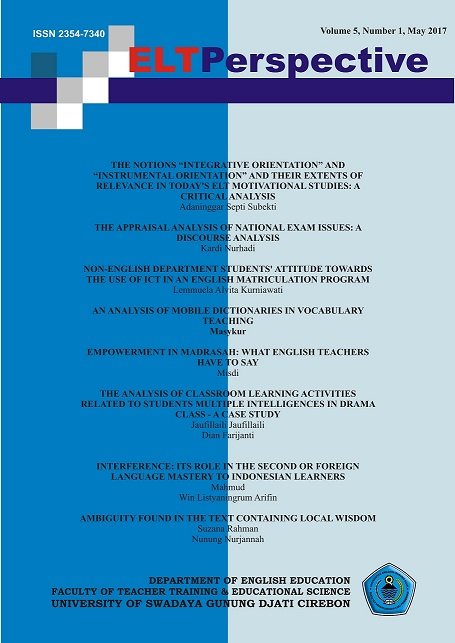The Analysis of Classroom Learning Activities Related to Students Multiple Intelligences in Drama Class - A Case Study
DOI:
https://doi.org/10.33603/perspective.v5i1.552Abstract
Drama is one of the lectures taught in English Education Department of UNSWAGATI. The classes at English Education department are categorized as big classes. Drama class demanded students to show their competence in any English skills, such as: listening, reading, writing and speaking. Drama could explore students’ multiple intelligences and it is an appropriate place to provide activities related to students’ multiple intelligences. Based on the explanation above, through this research, the writers had the aim to describe how is the students’ activity in drama class related to interactive domain of multiple intelligences based on McKenzie’s (2002), cited in Fauziati (2009: 112). Interactive domain of Multiple Intelligences consists of Linguistics domain, interpersonal domain and kinesthetic domain. Based on McKenzie’s (2002) cited in Fauziati (2009: 112), the learning activities in drama class are classified into three kinds of interactive domains, namely: linguistics, interpersonal and kinesthetic. The result showed why such learning activities in drama class are classified into each domain because they fullfil the characteristics of each intelligence. Linguistics deals with words and language, interpersonal deals with other people’s feeling and kinesthetic deals with body movement control.
Â
Keywords: multiple intelligences, interactive domains, linguistics, interpersonal, kinesthetic, drama class
References
Brown, H. D. 2000. Principles of Language Learning and Teaching. New York: Longman.
Brown, H. Douglas. 2000. Teaching by Principles: An Interactive Approach to Language Pedagogy. New Jersey: Prentice Hall Regents.
Currie, Karen L. 2003. “Multiple Intelligence Theory and the ESL Classroom – Preliminary Considerationsâ€. The Internet TESL Journal, Vol. IX, No. 4, April 2003.
Dornyei, Zoltan. 2008. Research Methods in Applied Linguistics: Quantitative, Qualitative and Mixed Methodologies. Oxford: Oxford U.P.
Fauziati, Endang. 2009. Reading on Applied Linguistics: A Handbook for Language Teacher and Teacher Researcher. Surakarta: Era Pustaka Utama.
Fauziati, Endang. 2010. Teaching English as a Foreign Language. Surakarta: Era Pustaka Utama.
Gardner, Howard. 1983. Frames of Mind. New York: Basic Books.
Gardner, Howard. 1993. Multiple Intelligences: The Theory in Practice. NY: Basic Books.
Gardner, Howard. 2000. Intelligence Reframed: Multiple Intelligences for the 21st Century.
New York: Basic Book.
Harmer, Jeremy. 2005. How to Teach English: An Introduction to the Practice of English Language Teaching. Essex: Longman.
Huda, Nuril. 1990. Language Learning and Teaching: Issues and Trends. Malang: IKIP Malang.
McKeachie, Wilbert J. et al. 1999. Teaching Tips: Strategies, Research, and Theory for College and University Teachers. Toronto: Health and Company.
Nation Paul. 1996. “Group work and language learningâ€, In Kral, Thomas (Ed.). Teacher Development: Making the Right Moves. Washington, D.C.: English Language Program Division United States Information Agency.
Wilheim, Jeffrey D., 2002. Action Strategies for Deepening Comprehension. New York: NY: Scholastic Professional Books.
Downloads
Published
How to Cite
Issue
Section
Citation Check
License
- Authors retain copyright and grant the journal right of first publication with the work simultaneously licensed under a Creative Commons Attribution - Share Alike 4.0 Internasional License (CC-BY-SA) that allows others to share the work with an acknowledgment of the works' authorship and initial publication in this journal.
- Authors are able to enter into separate, additional contractual arrangements for the non-exclusive distribution of the journals published version of the work (e.g., post it to an institutional repository or publish it in a book), with an acknowledgement of its initial publication in this journal.
- Upon receiving the proofs, the Author/Editor agrees to promptly check the proofs carefully, correct any errors, and authorize the publication of the corrected proofs.
- Authors should submit the signed copyright transfer agreement form (CTA Form) along with the checked (and corrected proofs).










